River Exe Fishing, from Source to Sea
With everything from salmon to sea bass present, the River Exe system is a fascinating area that encompasses coarse, game and sea angling alike. With over three decades exploring its waters, Devon guide and author Dom Garnett is here to guide you to the best places to fish and species to target on the Exe.
From the first time I laid eyes on it, the River Exe seemed a river of many possibilities. In fact, it is so crazily varied you sometimes wonder how stretches just a few miles apart can be the same river. Up in the hills above Tiverton, it’s sparkling, stony and just screams trout. At the opposite end, however, it has heavy tides and spans a kilometre across at high water. Pretty much all of it has fish, however, even the bits where traffic hums and concrete bridges span the streets of Exeter and Tiverton.

From urban sprawl to idyllic Exmoor, the Exe is a river of contrasts
Indeed, there might are more famous rivers and better places for specimen fish, but you’d struggle to find a place as varied as the Exe. Its waters are not without their issues these days, but it remains a magical place. The Romans could have told you this 2,000 years ago, with the name itself stemming from the old word Isca – which apparently purports to an ‘abundance of fish’.
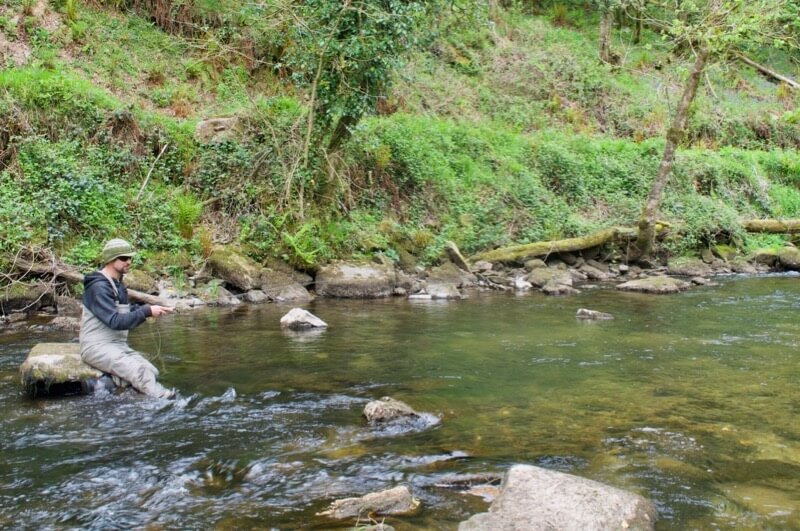
I’ll let you judge for yourselves if that still rings true, but perhaps a logical way to organise this article is in three main chunks: lower, middle and upper Exe. Roughly speaking, this gives us sea fishing in the tidal water, followed by coarse fishing, finally giving way to game or fly fishing as we get nearer to its source, up on Exmoor National Park. Enough fishing to keep you busy for a lifetime!
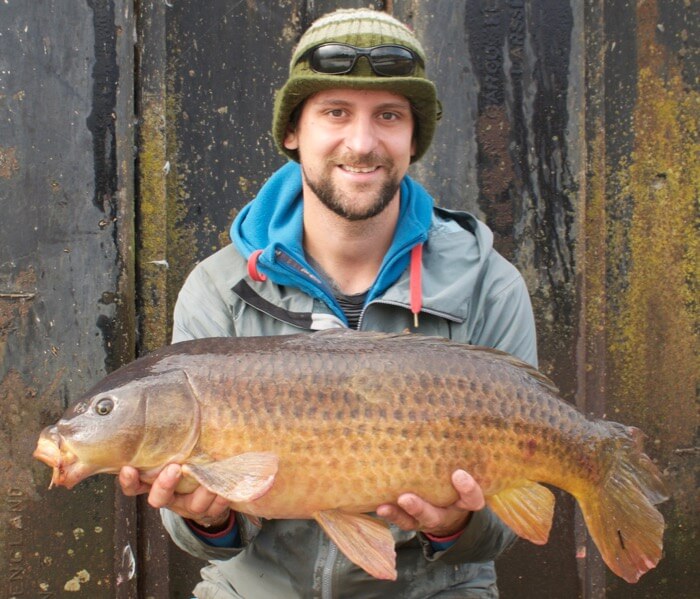
A fine tidal river carp. The Exe is always capable of a surprise!
The Exe Estuary and lower reaches: Sea fishing
My intention is not to write a sea fishing article here, but any description of the lower Exe would be incomplete without mentioning the tidal river. Besides some excellent sea and lure fishing at places like Exmouth and Dawlish (both good for beach casting, lure and LRF sport!) there are tons of spots worth a cast in the salty reaches of the River Exe itself.
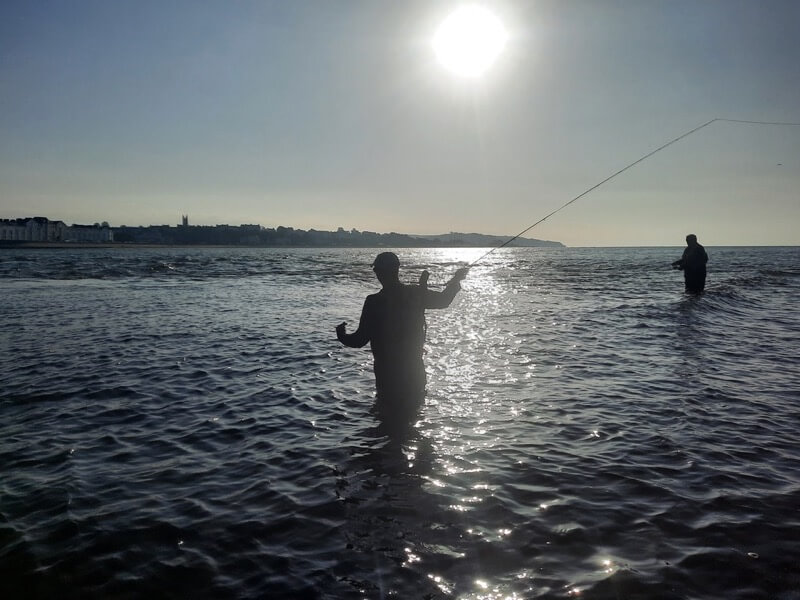
Anglers fish the mouth of the Exe, an ideal place for lighter tackle
Starcross, Lympstone and Dawlish Warren are just three locations that can fish well and still count as free fishing as you are in the salty stuff. The most common species here are mullet and school bass, but there are also flounder and other fish. Talking of bass, the best event in my lifetime for these brilliant fish has been the establishment of a protected “nursery” area in the Exe. This has meant the eradication of commercial nets and a major increase in small bass. Some of which have to become bigger bass, right?!
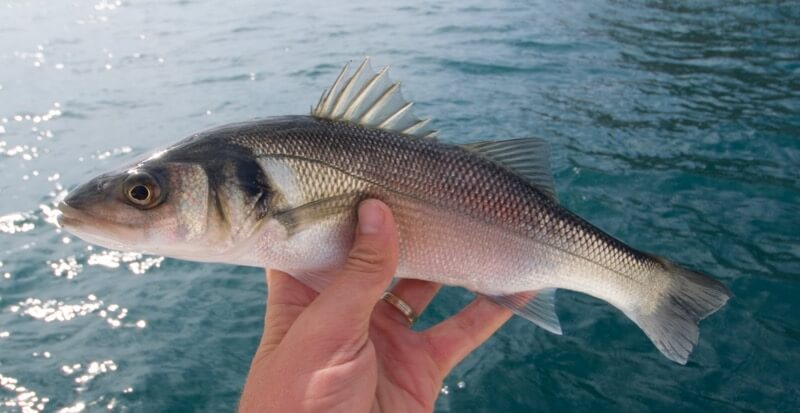
A typical, small but scrappy Exe school bass
These fish can be excellent fun on light lure or fly tackle. Most are under a pound, but you never quite know what you’ll find, because the odd “keeper” size fish of over 2lbs and bigger also shows. Please put these slow-growing fish back if you’re lucky enough to get one- after all, a five-pounder will be a “breeder” that has taken over 12 years to get to that size. And this is before we mention the amount of sewage kicked out by South West Water- which also means you should always think of good hygiene wash hands after fishing.
Various states of tide suit different marks, but generally a good plan is to have a low tide recce and fish as the water comes up. The bass often like the bits that really shift! Take great care here, though, because the Exe has big tides and some very soft, squelchy ground. Waders and an escape route are a must.
As for tactics, in the right conditions you could happily fish a bass or flattie rod, or indeed lure tackle, for maximum sport. Lure fishing is my first choice, closely followed by a fly rod- and you can’t go wrong with anything based on one of their main estuary food sources, the sandeel! For bait angling, worms will work but the offering par excellence for bass or winter flounder is peeler crab.
Changing times and species – coarse fishing and mullet from Countess Wear to Weirfields
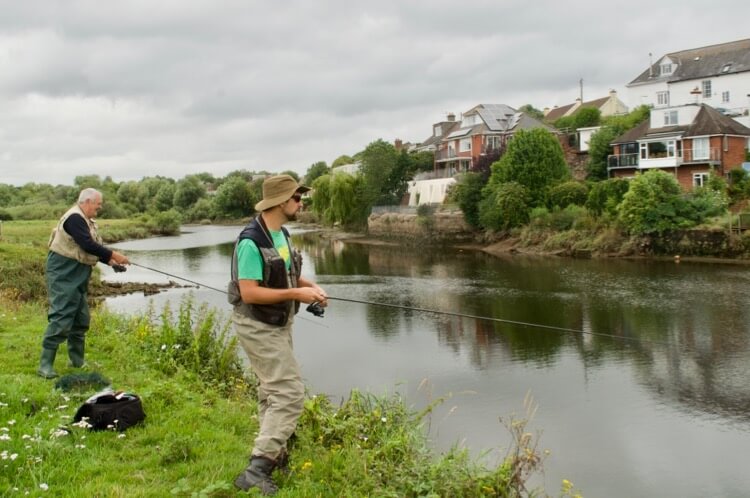
Fishing the Exe at Countess Wear, especially good for mullet
Moving upstream, we come to some decent club and day ticket fishing at Countess Wear. Parking is tricky- but your best bet is right where you cross the Exe over Bridge Road at the end of the A379. It’s still heavily tidal, but you’ll start to notice more coarse fish and casting here demands an Exeter and District Angling Association licence, which can easily be bought online.
Have a good walk at low tide to suss out the features and you’ll discover a great deal. These days, the most dominant species from spring right through to autumn are thin and thick lipped grey mullet by the thousand. Not everyone’s cuppa, but they will respond to feeder fished bread or, my favourite way of getting them, a spinner tipped with real or fake worm. Fly fishing can also work, especially if you can find the spots where they stop and graze the mud.
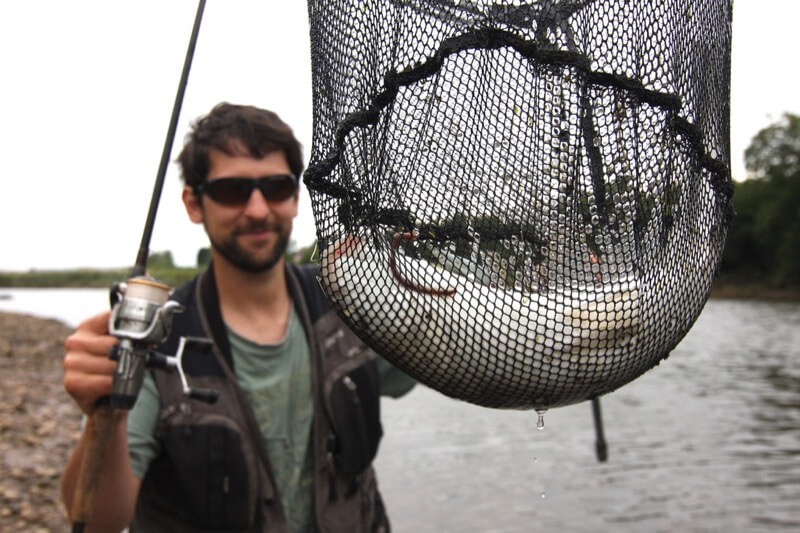
A mullet falls to the worm-tipped spinner
Other methods include stick float fishing, groundbait feeder or even specimen tactics. There are good numbers of dace in the faster water, as well as odd roach, perch, chub and some big bream. The river also holds carp and the occasional pike, although these can be hard to locate. Prebaiting could pay dividends for the carp- and most anglers fish from low up, trying the various eddies and slacks.
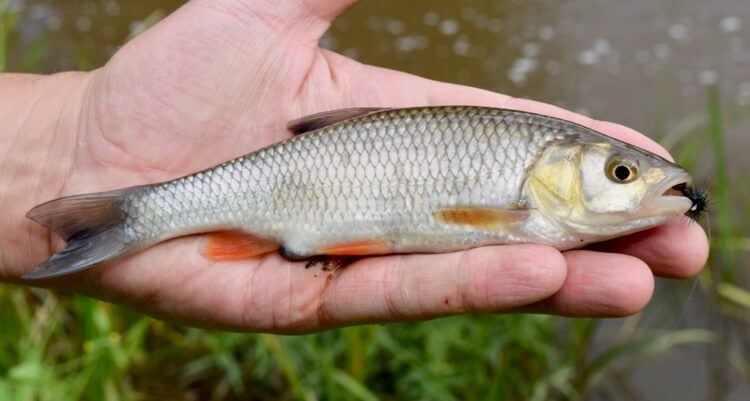
A fly caught chub. These fish are present through much of the lower river
Moving further towards Exeter itself, you then come to Weirfields, running from behind Double Locks Inn towards town (of course, you also have the Exeter Canal here, but that’s another story!). Do check club maps and signs carefully because some stretches of Exe are private as we approach the city. Weirfields has a similar mix of coarse fish, including dace, chub and carp well into double figures. If in doubt, stick float or feeder fished maggots are an ideal starting point for getting a few bites. See the Exeter DAA club website for specific rules on carp and night fishing.
Fishing in Exeter City: The Urban Exe
As we get into the heart of Exeter itself, the scenery is a bit greyer but there’s a lot of under-utilised fishing to explore. This runs from the area in front of the Port Royal pub, right through the Quay and up to Mill On Exe. Again, it’s Exeter DAA controlled- and with the concrete, you must be well prepared. At minimum you should have a decent landing net and unhooking mat, regardless of your chosen method. Do check the club maps to avoid trouble and always be organised and avoid leaving valuable kit on display or where it might get cycled or walked over!
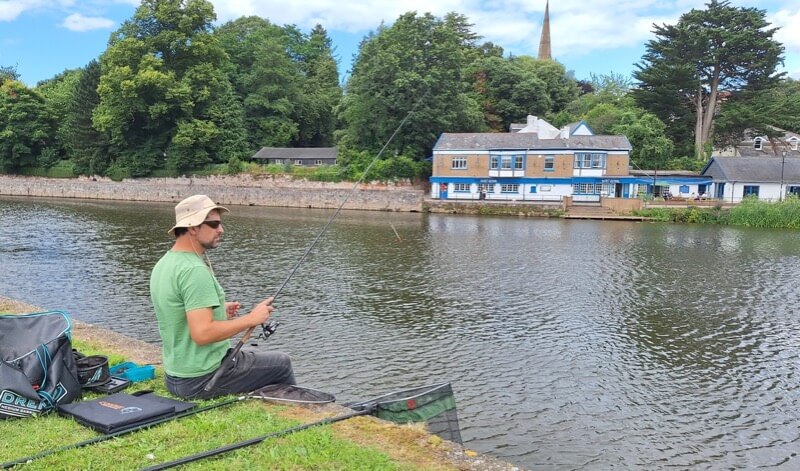
Float fishing in the town- near the canal entrance is a good bet for roach
I rarely see anyone fishing the city centre beyond the odd lure angler. A real shame, because it can be excellent. The mix of species has changed a lot since I was a teenager fishing here. Where the big bream shoals have gone, I’m not sure. We once caught huge bags from right in front of Exeter’s notorious Quayside nightclubs, but nowadays it’s the odd straggler which can weigh 8lbs+. However, other fish have bounced back, in particular the roach and perch.
One excellent place to try for pleasure fishing is the grassy area where the canal and river meet. Casting off here with either a float or feeder, you can enjoy some wonderful roach fishing in the summer and autumn, with odd perch and other species thrown in. There’s welcome space to avoid the foot traffic and if you fish fairly light, with maggots or casters to 3lb line, you’ll get lots of action.
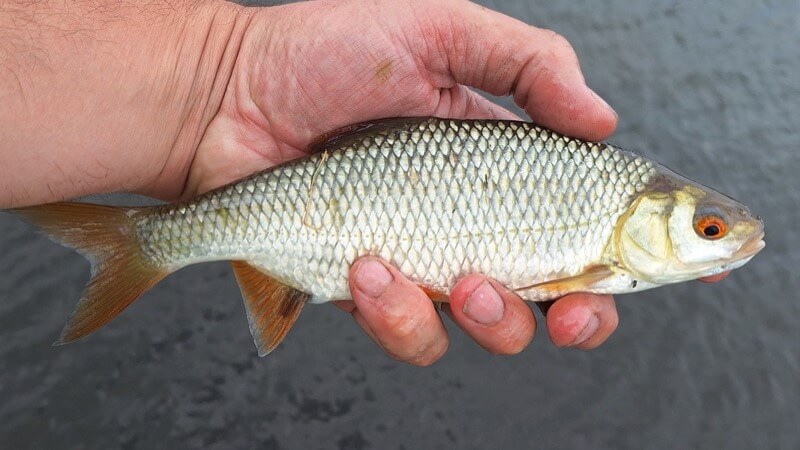
A typical Exe roach. These fish are making something of a comeback
One note here on all of the urban Exe, however, is to be prepared and to take a long handled net. This is a must for any longer drops, but it should also go without saying that you mustn’t fish anywhere that you cannot land fish- it simply isn’t fair on your quarry.
Other parts of the urban river have more roach, good numbers of dace and some chub, too. Being a bit of an oddball, I sometimes like to have a wander in low summer conditions and flick a fly at these fish. The dace are highly susceptible to a small F-Fly, just watch that back cast and Joe Public about!
As for lure and predator fishing, there are bites to be had but you have to work at it. The piking is quite frankly a pale shadow of what it once was, following an era of intense fishing pressure, both legal and illegal, although there are still a few about and one can only hope they bounce back in time. If you are lucky enough to find pike, please, please, please treat them with great care and avoid advertising their presence on social media!
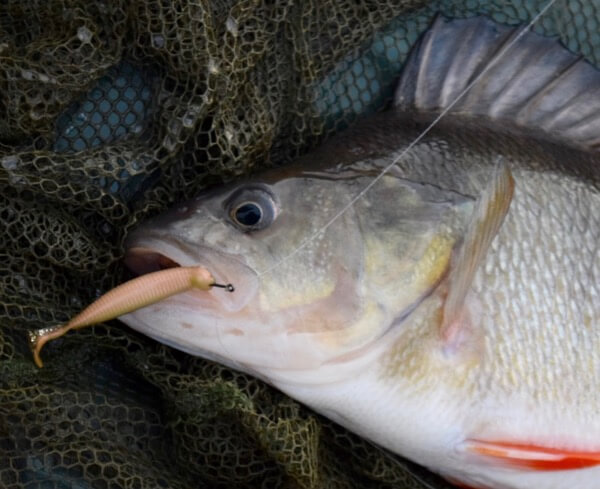
Try small soft plastics for perch- and always pack an unhooking mat!
Perch tend to be a much safer bet, with a fair few smaller fish and the odd larger unit of a pound or more. Any structures or places where there is a little more depth or slack water are worth a punt. Small soft plastics and weedless jigs are not only effective, but less easy and heart-breaking to lose on snags than traditional lures! Don’t even think about fishing for any predators without a quality net and large unhooking mat, as per club rules, because concrete dominates the city centre.
Last but not least, whichever method you fish it is worth roving swims because the urban Exe can often be a case of feast and famine. Why sit biteless in one spot when there could be a whole shoal of fish just fifty yards away?
Moving out of town… the last of the coarse fishing
For those who like their own space when fishing, we should also mention two underfished sections of Exe also on EDAA club books. First up, there is a slightly faster stretch of water running between Exwick and Cowley. This section is ideal to run a stick float through or cast a small but heavy feeder. Fish maggots and you’ll find some good roach, which have bounced back somewhat in the last decade. Waders are a must to access some spots- but please be careful and avoid high water conditions.
Finally, you also have some interesting fishing where the Exe runs parallel to the Creedy, just as you leave the city and join the road to Crediton. Indeed, a short stretch of both these rivers can be fished on the same ticket and have some welcome mystery. There are roach, chub and dace, but also rumours of carp and even the odd barbel. What on earth these are doing in the Exe, or whether they are good news in the long run, is anyone’s guess- but fishing a big bait, the determined angler might just get the classic “three foot twitch”!
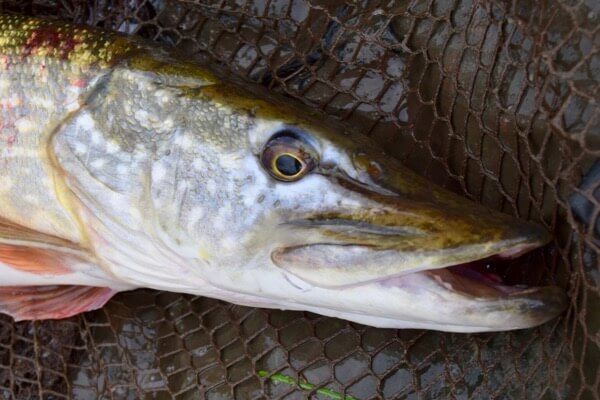
A fit River Culm pike. Get your walking boots on to find the better fishing
Very briefly, we should also mention that Exeter DAA also have some water on the River Culm- which is a pretty Exe tributary with a great mix of fish. It’s a lovely summer water to catch chub, while there are also some other good fish, including pike that are modest in size but punch hard on suitable tackle. You can find maps, rules and online tickets info for all the above. It’s a well-run and regularly bailiffed club, so please don’t be a chump, play fair by getting a ticket, sticking to the rules and reporting anything dodgy.
Game on: moving into fly fishing territory on the Exe
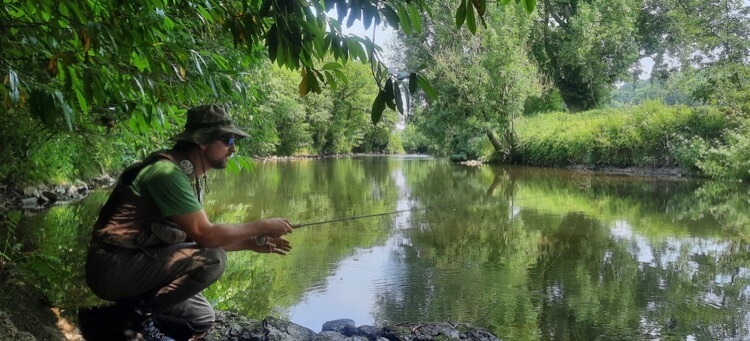
Midsummer fly fishing on the Exe- an ideal time to find rising fish
Once we get out of Exeter and on the road to Tiverton and Exmoor, the river becomes faster, shallower and much better suited to game fish. Increasingly that means grayling as well as trout. It’s getting on the damned water that is the tricky part- as much of the river is swallowed up by private syndicates, while many miles are still owned by the same family who’ve had it from Norman times (I know what you’re thinking, bloody French!).
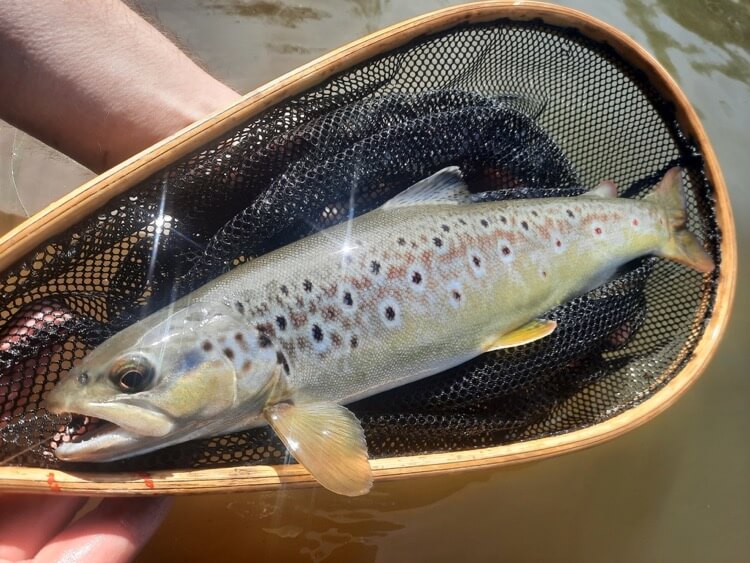
The Exe and its tributaries produce some fine looking fish – and not all are small
This could perhaps shift as the river changes, however. While nobody is delighted to see the decline of Exe salmon, this might also open up more of the river for trout, grayling and coarse fishing, but in the meantime there are a few stretches you can get onto with a little digging.
Between Bickleigh and Tiverton, there is now around 1km of excellent trout and grayling water. This beat, run by John Deprieelle, must be booked in advance and is strictly catch and release, but is only £15 a day and also offers winter grayling.
Other beats are available on a booking basis from RETA (River Exe and Tributaries Association) including water at Bickleigh and Exebridge. Do make sure you book well in advance, however. Tiverton Fly Fishing Club also exists, but only offers fishing for those within the EX16 postcode, sadly.
Finally, for the best of the fishing as we get right up on Exmoor, there are the wee small parts of the Exe and several tempting tributaries to explore. Dulverton Angling Association is ridiculous value at £35 per year or just a quid for juniors!
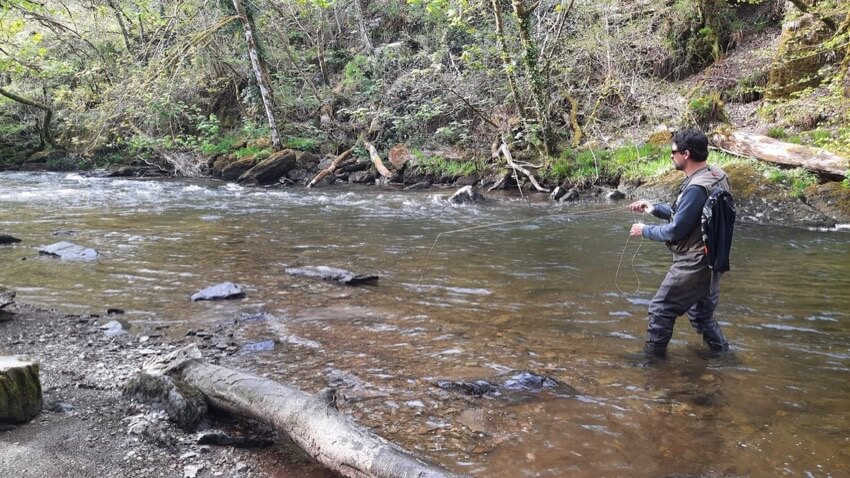
Fishing above Tarr Steps on the Barle- a stunning Exe tributary with plenty of fish. Exmoor is a little cooler than the middle Exe, hence the best sport is from early May onwards.
Also worth a punt for some really cute nearby fishing on some further Exe tributaries are the brilliant FishPass app and the waters of the pretty River Barle, now available by booking directly with Tarr Farm Inn.
Flies and tactics for Exe trout and grayling
For most of the upper Exe, you can expect pretty and obliging trout averaging 7- 10 inches, along with occasional fish that run to 15”+. Take realistic tackle for the river conditions with a view to getting maximum fight from your fish. For the broader bits of Exe, I like a 10ft 3 or 4wt rod- which is also ideal for nymphing. Up in the hills, however, you might want to step down as little as 7 or 8 ft in a 3 weight. A rod’s length of tapered leader plus 3lb tippet is par for the course- but if the river is low and the fish wily in mid summer, an excellent shout is to keep back a bit and extend that leader to 12ft or more.
Fly hatches are not what they used to be on the river, but there are still reasonable numbers of sedge and various olives. A Grey Klinkhamer, Olive Emerger or local favourite the Beacon Beige are all worth a cast for dry fly fans, but avoid going too large. A size 16 is usually about perfect, unless the sedges get going, in which case a size 12 Elk Hair caddis is a good choice.
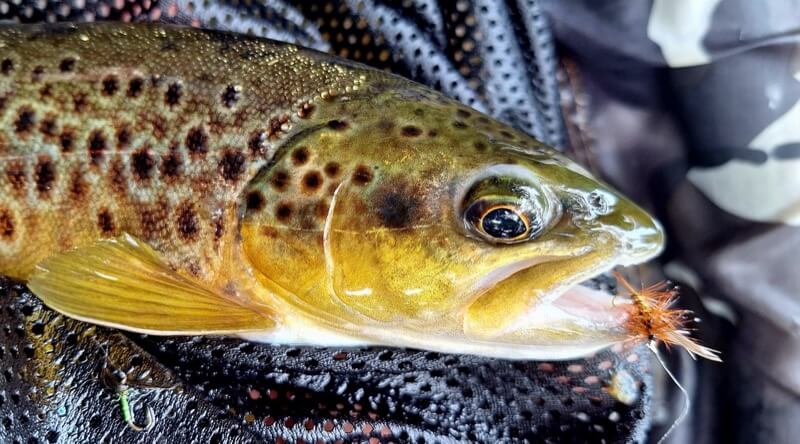
This terrestrial sipping fish took a Wickham’s Fancy dry, close to tree cover
For mid summer and shallow water, it’s also worth carrying some terrestrials and tiny midges. For fish holding under trees, two old but gold flies I love for the Exe are a Coch-y-Bonddu and Wickham’s Fancy, in a size 14-16. For fussy fish and slow days, however, another useful angle is to try a tiny midge pattern right down to a 20. These tiny flies are always present, after all, and a great dodge is to double up and fish two dry flies on your cast – one regular and one tiny little speck.
Not that dry fly is the only way to fish, of course, and in fact most of the successful grayling anglers seem to be using modern nymphs. Euro Nymphing can be brilliant in the faster and deeper sections of Exe- but don’t discount simple “Klink and Dink” or fishing a beaded fly under a simple indicator. This is probably hardly surprising, as the one species of invertebrate that seems to be multiplying on the Exe and Culm these days seems to be the freshwater shrimp. Could this be the reason the grayling are doing so well? They are not of a stamp to rival the chalk streams, but pound plus fish quite often show up.
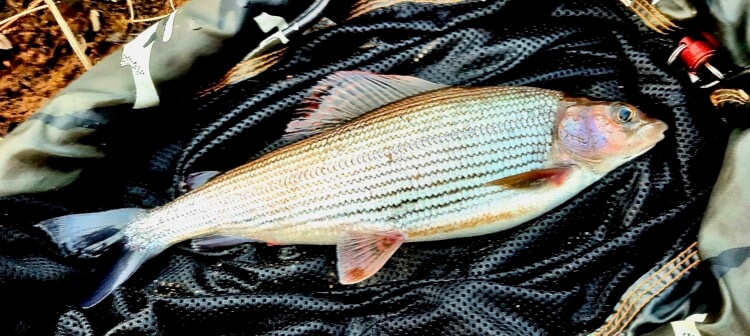
A plump Exe grayling. These fish are fattening up well on shrimp
Another quick point to make here is biosecurity. Not only does the Exe have some invasive plants, but there is also the alarming presence of signal crayfish. Do please check, clean and dry your gear between trips and do your bit to avoid these and other issues spreading between rivers!
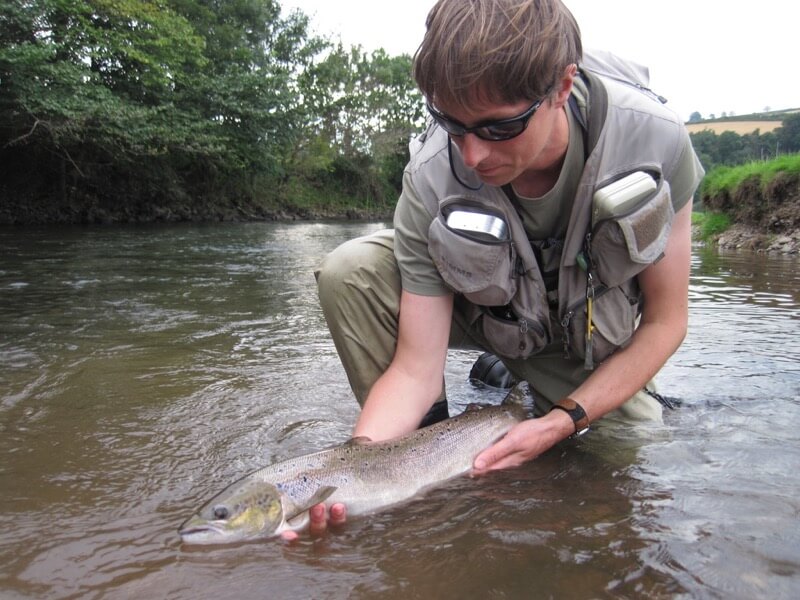
Ben Garnett carefully releases an Exe salmon. While stocks are diminishing, success is still possible.
Once prolific and seen as the absolute pinnacle of fishing on the Exe, it is a sad but undeniable fact that salmon are in decline on the river. Recent seasons have seen some of the lowest returns of all time- exacerbated by factors such as climate change and connected summer lows, as well as pollution and poorly considered hydropower developments.
That said, there are still runs of this iconic fish, which must be treated and returned with more respect than ever in these precarious times. I am at best a very occasional salmon angler, but would recommend keeping a close eye on conditions and picking your spot with care. The best of the season seems to be late, with September the peak, and anglers eagerly hoping for rain. Here are some options worth investigating:
Exeter & District Angling Association offer some amazing value spots to try, which are well worth a look in the lower river.
RETA also have several beats with salmon a possibility, albeit more costly.
Last but not least, perhaps the most exciting of all the Exe tributaries is the River Barle, which can still get a decent run of fish late in the season. The Tarr Farm Inn beat has five tempting pools and the possibility of battling a powerful fish in a uniquely intimate setting. A real bucket list experience!
MORE TO READ & GUIDED DAYS ON THE RIVER EXE WITH DOM GARNETT
An experienced guide, Angling Times columnist and author of six books including Flyfishing For Coarse Fish and Crooked Lines, Dom Garnett can offer top quality guided fishing days across various stretches of the River Exe and nearby waters in Devon and Somerset. Find out more and catch his regular blog.
Similar articles
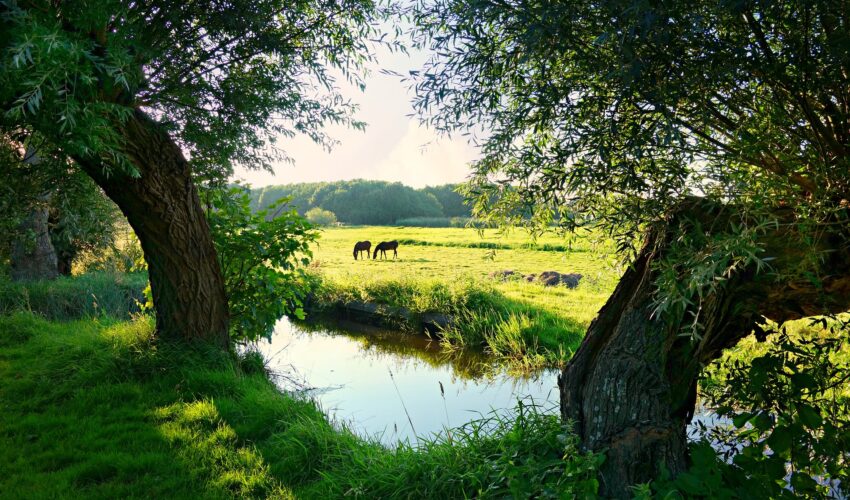
River Fishing – A guide to getting started
Are you thinking of going for a trip to the river in 2025 but find yourself filled with trepidation because you have never fished running water before? Well I want you to relax. Let us take the mysteries out of…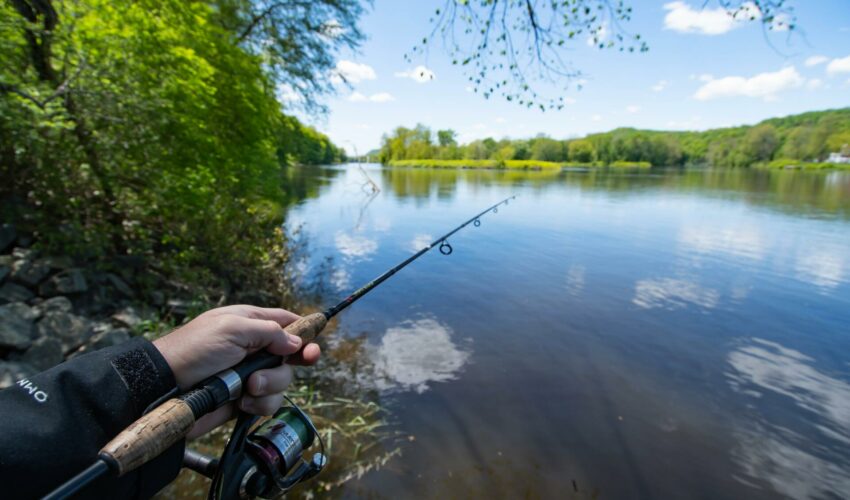
A guide to fishing licences in 2025
Whether you want to become a new angler or you’ve been fishing for years, you will be required to obtain the Environment Agency Rod Licence. In this article we explain what you’ll need if you want to go fishing in…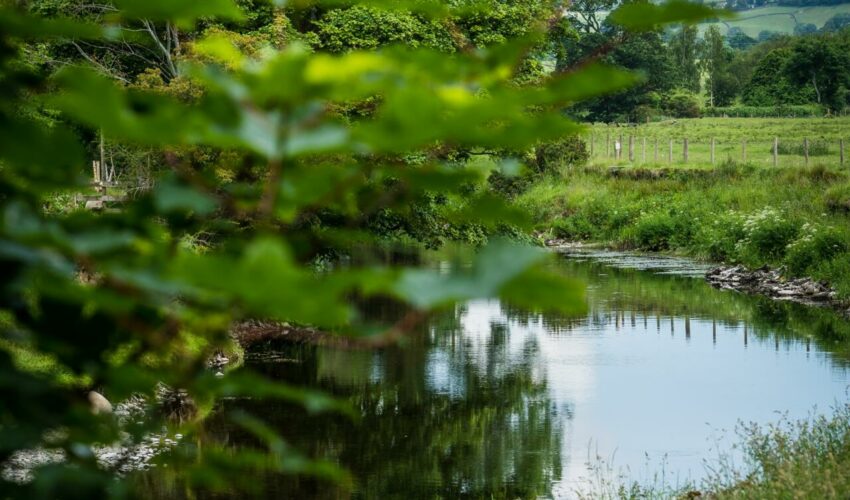
Make the most of the 2025 river season with this in-depth guide to fishing rivers
If you’re new to fishing rivers, or just fancy a change from fishing stillwaters, this guide will help you make the most of the new 2025 river fishing season. With advice on reading the water, what species to fish for…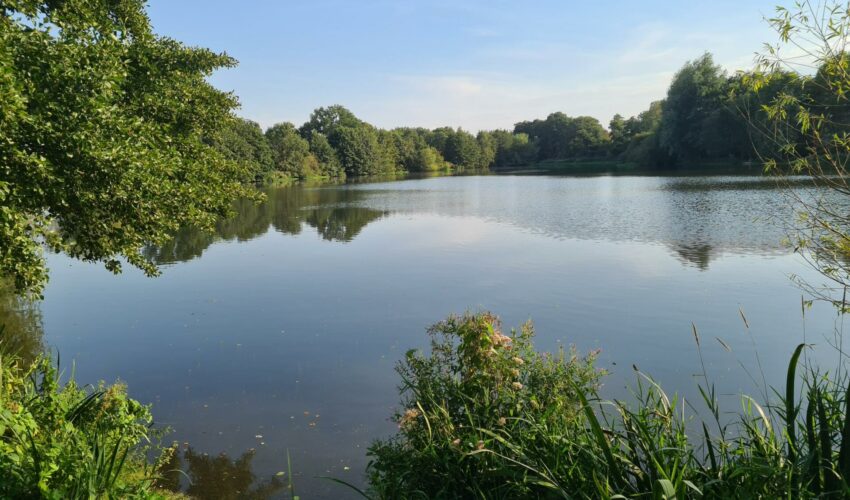
Our guide to fishing this spring (2025)
With the worst of the weather over (we hope!) and with spring finally here, it’s time to clean out that tackle box and get on the bank for some spring time fishing.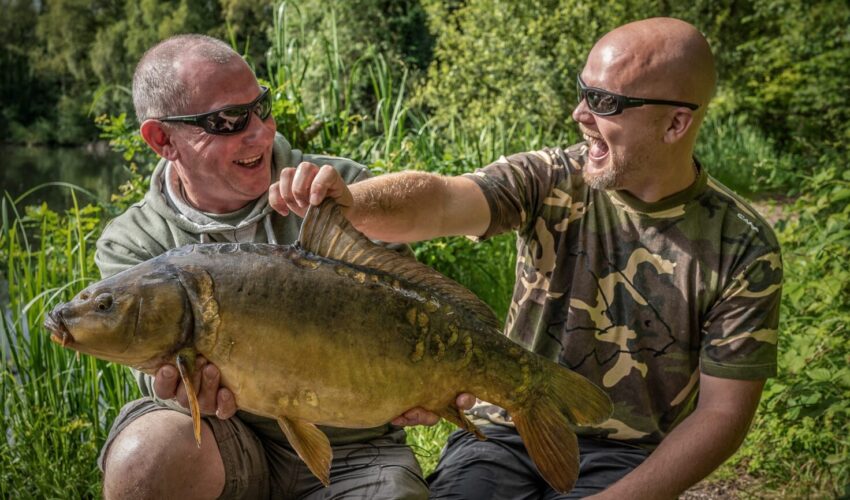
Take a friend fishing
Get ready to hit the water! From April 18th to May 4th, 2025, you can get a free fishing license to take a buddy out and show them what fishing’s all about. Yep, free! It’s all part of the “Take…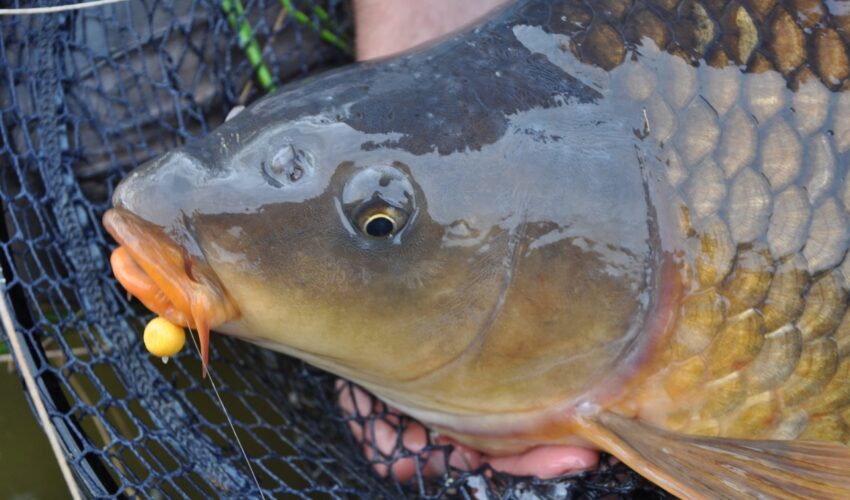
Fishing tips for hard days: How to get more bites
It happens to the best of anglers. Whether conditions are tough, the fish are moody, or our plans simply aren’t working, there are days we struggle. But what can you do to catch fish that seem unwilling to cooperate? There’s…Search by Region or County
Find new places to go fishing in your local area or county by choosing your destination below





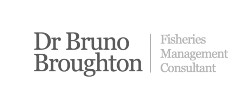


Comments